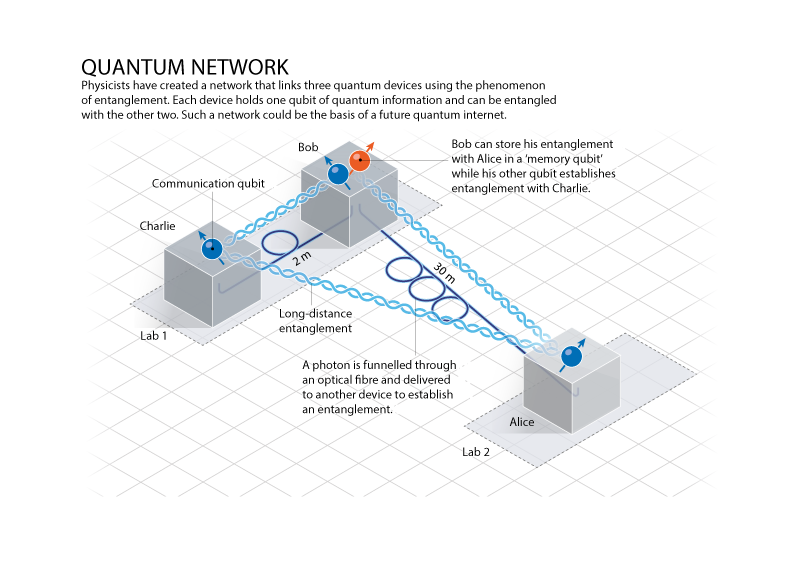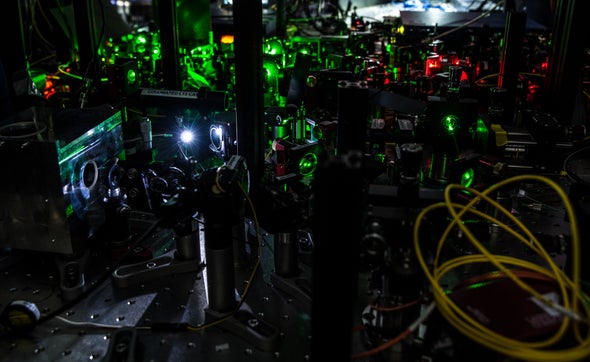Physicists have taken a major step towards a future quantum version of the Internet by linking three quantum devices in a network. A quantum internet would enable ultrasecure communications and unlock scientific applications such as new types of sensor for gravitational waves, and telescopes with unprecedented resolution. The results were reported on 8 February on the arXiv preprint repository.
“It’s a big step forward,” says Rodney Van Meter, a quantum-network engineer at Keio University in Tokyo. Although the network doesn’t yet have the performance needed for practical applications, Van Meter adds, it demonstrates a key technique that will enable a quantum internet to connect nodes over long distances.
Quantum communications exploit phenomena that are unique to the quantum realm—such as the ability of elementary particles or atoms to exist in a ‘superposition’ of multiple simultaneous states, or to share an ‘entangled’ state with other particles. Researchers had demonstrated the principles of a three-node quantum network before, but the latest approach could more readily lead to practical applications.
Entangled web
At the heart of quantum communications is information stored in qubits—the quantum equivalent of the bits in ordinary computers—which can be programmed to be in a superposition of a ‘0’ and a ‘1’. The main purpose of a quantum network is to enable qubits on a user’s device to be entangled with those on someone else’s. That entanglement has many potential uses, starting with encryption: because measurements on entangled objects are always correlated, by repeatedly reading the states of their qubits, the users can generate a secret code that only they know.
In the latest demonstration, physicist Ronald Hanson at the Delft University of Technology in the Netherlands and his collaborators linked three devices in such a way that any two devices in the network ended up with mutually entangled qubits. They also put qubits at all three devices in a three-way entangled state, which, among other applications, can enable three users to share secret information.
Each of the Delft devices stores quantum information in a synthetic diamond crystal—more precisely, in the quantum states of a defect in the crystal, where a nitrogen atom replaces one of the carbons.
In such a diamond device, researchers can prod the nitrogen qubit to emit a photon, which will be automatically entangled to the atom’s state. They can then funnel the photon into an optical fibre and deliver it to another device, helping to establish entanglement between remote qubits. In a tour-de-force experiment in 2015, the Delft team successfully entangled two diamond-based devices, and used them to confirm some crucial predictions of quantum mechanics.
Quantum memory
One of the three devices in the team’s latest experiment—the one in the middle of the network—was also set up to store information in a ‘quantum memory’, which can hold data for longer than the other qubits and was key to setting up the three-way entanglement. The memory qubit used carbon-13, a non-radioactive isotope that makes up around 1% of naturally occurring carbon. Carbon-13 has an extra neutron in its nucleus, so it acts like a bar magnet. The researchers used an active electron in the nitrogen defect as a sensor, to locate a nearby carbon-13 nucleus. By manipulating the electron, they were able to nudge the carbon nucleus into specific quantum states, turning it into an additional qubit. Such carbon quantum memories can keep their quantum states for 1 minute or more—which in the subatomic world is an eternity.
The carbon memory enabled the researchers to set up their three-device network in stages. First, they entangled one of the end nodes with the nitrogen in the central node. Then they stored the nitrogen’s quantum state in a carbon memory. This freed the central nitrogen qubit to become entangled with the qubit at the third node. As a result, the central device had one qubit entangled with the first node, and another simultaneously entangled with the third (see ‘Quantum network’).

The technique required years of refinement. The carbon qubit needs to be sufficiently well insulated from its environment for its quantum state to survive while the physicists conduct further operations—but still be accessible so that it can be programmed. “You want to store a quantum state, so it should be shielded. But it should not be shielded too much,” Hanson told a reporter during a visit to his lab in 2018.
This and other challenges made the experiment more difficult than a two-node network, says Tracy Northup, a physicist at the University of Innsbruck in Austria. “Once you seriously try to link three, it gets significantly more complicated.”
Storing information in a node enabled the team to demonstrate a technique called entanglement swapping, which could turn out to be as crucial for a future quantum internet as routers are for the current one.
Material concerns
The Delft team is not the first to have successfully linked three quantum memories: in 2019, a team led by physicist Pan Jianwei at the University of Science and Technology of China in Hefei did so using a different type of qubit, based on clouds of atoms rather than individual atoms in a solid object. But that experiment could not yet produce entanglement on demand, says Northup. By detecting photons, the Hefei team could only “retroactively extract the fact that the entanglement was there”, not that it is still available for further use.
Van Meter says that atomic-cloud qubits are more limited in what they can do, so it could be very difficult for the Hefei team to do entanglement swapping—although perhaps not impossible. “I would never say never with the Pan group.”
Mikhail Lukin, a physicist at Harvard University in Cambridge, Massachusetts, calls the Delft experiment “heroic”, but adds that its performance is slow, showing that nitrogen defects also have limitations. Lukin’s team is working on similar experiments in diamond with silicon defects, which are much more efficient at interacting with photons, he says. Other teams have built networks with ions trapped in an electromagnetic field, or with defects in crystals of rare-earth elements, which can interact with infrared photons that can travel along kilometres of optical fibre without significant losses. (Optical fibres are poor at carrying the visible-light photons emitted by nitrogen defects in diamond.)
In their paper, Hanson and his co-authors suggest that their techniques will “provide guidance for similar platforms reaching the same level of maturity in the future”.
This article is reproduced with permission and was first published on February 17 2021.


